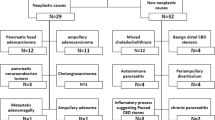Abstract
Purpose
The purpose of this study was to determine the incidence of occult obstructing malignancy in the setting of asymptomatic biliary ductal dilatation incidentally detected and without identifiable cause on contrast-enhanced CT.
Methods
A retrospective search identified patients with biliary ductal dilatation on contrast-enhanced CT from March 30, 2007 to November 1, 2017. Patients with biliary symptomatology or clinical concern for an obstructing process, an explanation for biliary ductal dilatation on index CT, intrahepatic without extrahepatic biliary ductal dilatation, concurrent pancreatic ductal dilatation, and inadequate follow-up were excluded. A reference standard of at least 1 year of imaging follow-up or 2 years of clinical follow-up was used to exclude occult obstructing malignancy.
Results
156 patients were included; 120 patients met imaging follow-up criteria and 36 patients met clinical follow-up criteria. No cases of occult malignancy were identified as the source of biliary ductal dilatation (95% CI 0.0–1.9%). LFTs were available for 131 patients, of which 36 were elevated (27%). One case demonstrated a 1.2-cm ampullary adenoma on endoscopic retrograde cholangiopancreatography (occult on follow-up MRI, normal LFTs at the time of the index CT).
Conclusion
Asymptomatic biliary ductal dilatation incidentally detected and without identifiable cause on contrast-enhanced CT is likely benign in patients with normal LFTs, and further workup may not be warranted.

Similar content being viewed by others
References
Atkinson CJ, Lisanti CJ, Schwope RB, et al. Mild asymptomatic intrahepatic biliary dilation after cholecystectomy, a common incidental variant. Abdom Radiol (NY) 2017; 42(5):1408-1414
Sebastian S, Araujo C, Neitlich JD, Berland LL. Managing incidental findings on abdominal and pelvic CT and MRI, Part 4: white paper of the ACR Incidental Findings Committee II on gallbladder and biliary findings. J Am Coll Radiol 2013; 10(12):953-956
Bruno M, Brizzi RF, Mezzabotta L, et al. Unexplained common bile duct dilatation with normal serum liver enzymes: diagnostic yield of endoscopic ultrasound and follow-up of this condition. J Clin Gastroenterol 2014; 48(8):e67-70
Malik S, Kaushik N, Khalid A, et al. EUS yield in evaluating biliary dilatation in patients with normal serum liver enzymes. Dig Dis Sci 2007; 52(2):508-512
Park JS, Lee DH, Jeong S, Cho SG. Determination of diameter and angulation of the normal common bile duct using multidetector computed tomography. Gut Liver 2009; 3(4):306-310
Peng R, Zhang L, Zhang XM, et al. Common bile duct diameter in an asymptomatic population: A magnetic resonance imaging study. World J Radiol 2015; 7(12):501-508
Senturk S, Miroglu TC, Bilici A, et al. Diameters of the common bile duct in adults and postcholecystectomy patients: a study with 64-slice CT. Eur J Radiol 2012; 81(1):39-42
Berland LL, Silverman SG, Gore RM, et al. Managing incidental findings on abdominal CT: white paper of the ACR incidental findings committee. J Am Coll Radiol 2010; 7(10):754-773
Kim JE, Lee JK, Lee KT, et al. The clinical significance of common bile-duct dilatation in patients without biliary symptoms or causative lesions on ultrasonography. Endoscopy 2001; 33(6):495-500
Rana SS, Bhasin DK, Sharma V, Rao C, Gupta R, Singh K. Role of endoscopic ultrasound in evaluation of unexplained common bile duct dilatation on magnetic resonance cholangiopancreatography. Ann Gastroenterol 2013; 26(1):66-70
Tamir S, Braun M, Issachar A, Bachar GN, Benjaminov O. Yield of magnetic resonance cholangiopancreatography for the investigation of bile duct dilatation in asymptomatic patients. United European Gastroenterol J 2017; 5(3):408-414
Baker HL, Caldwell DW. Lesions of the ampulla of Vater. Surgery 1947; 21(4):523-531.
Sato T, Konishi K, Kimura H, et al. Adenoma and tiny carcinoma in adenoma of the papilla of Vater–p53 and PCNA. Hepatogastroenterology 1999; 46(27):1959-1962
Chini P, Draganov PV. Diagnosis and management of ampullary adenoma: The expanding role of endoscopy. World J Gastrointest Endosc 2011; 3(12): 241–247
Martin JA, Haber GB. Ampullary adenoma: clinical manifestations, diagnosis, and treatment. Gastrointest Endosc Clin N Am 2003; 13(4):649-669
Chathadi KV, Khashab MA, Acosta RD, et al. The role of endoscopy in ampullary and duodenal adenomas. Gastrointest Endosc 2015; 82(5):773-781
Espinel J, Pinedo E, Ojeda V, Del Rio MG. Endoscopic management of adenomatous ampullary lesions. World J Methodol 2015; 5(3):127-135
Yeh BM, Liu PS, Soto JA, Corvera CA, Hussain HK. MR imaging and CT of the biliary tract. Radiographics 2009; 29(6):1669-1688
Author information
Authors and Affiliations
Corresponding author
Additional information
Publisher's Note
Springer Nature remains neutral with regard to jurisdictional claims in published maps and institutional affiliations.
Rights and permissions
About this article
Cite this article
Chalfant, J.S., Skaggs, A.W., Loehfelm, T.W. et al. Incidentally detected biliary ductal dilatation on contrast-enhanced CT: what is the incidence of occult obstructing malignancy?. Abdom Radiol 44, 4022–4027 (2019). https://doi.org/10.1007/s00261-019-02217-7
Published:
Issue Date:
DOI: https://doi.org/10.1007/s00261-019-02217-7




